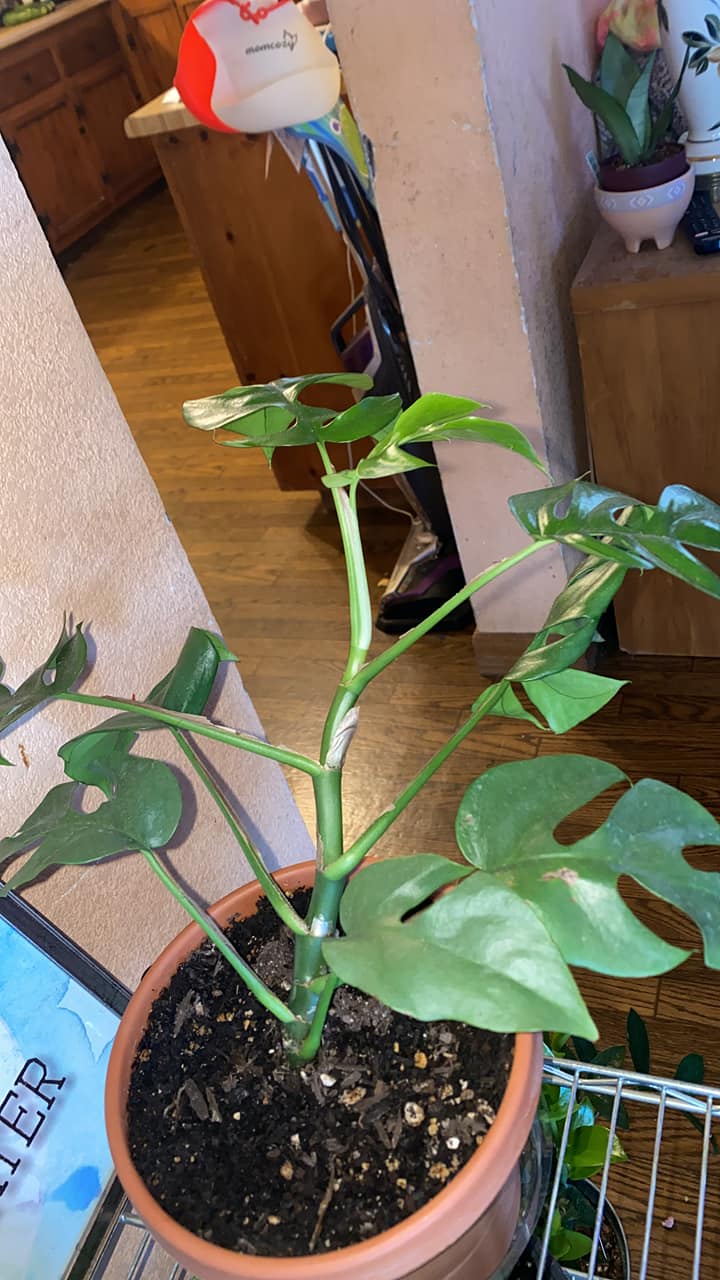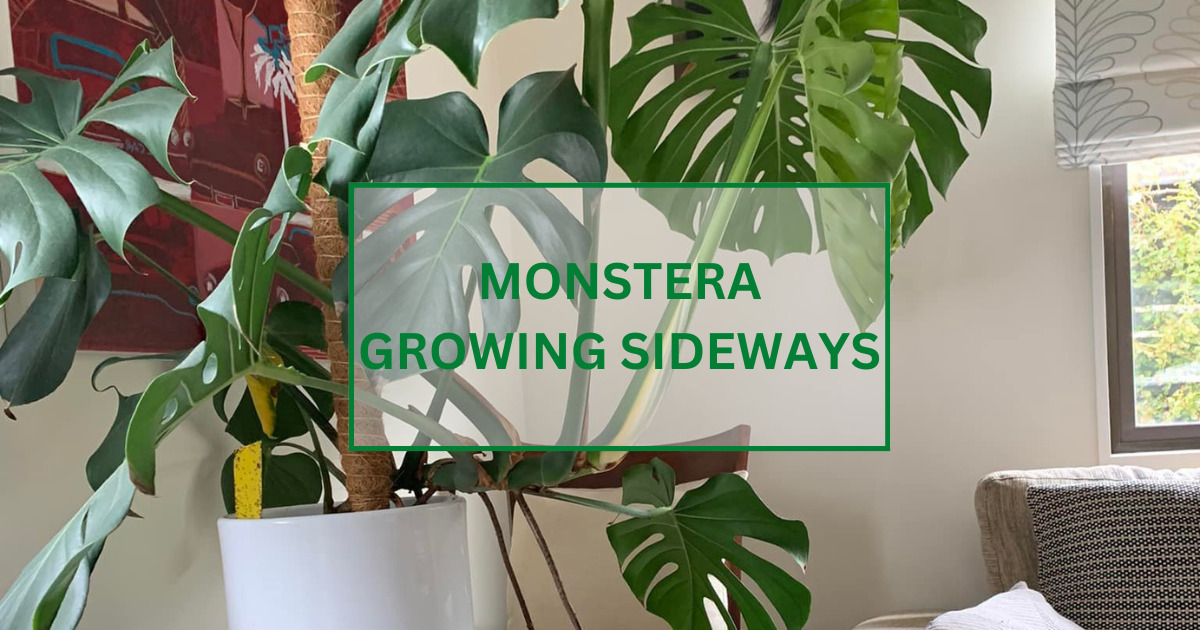As a Monstera fan, I’m super familiar with their bright leaves and how they’re simple to care for, making them a favorite part of any plant collection. But it’s pretty usual for some of us to get confused when our Monsteras start growing sideways. Even though this may look unsightly or problematic, don’t worry, I have a solution. In this blog post, I’m going to dig into the common causes behind this lateral growth and give you some handy tips to steer its growth back to normal.
Why Is My Monstera Growing Sideways?
A Monstera plant that is growing sideways or leaning over can be alarming, but usually indicates one of a few common issues that can be corrected. Monstera plants are natural climbers in the wild, so they require some specific care and conditions to grow properly upright in our homes.
| Issue | Cause | Solution |
|---|---|---|
| Lack of Support | In their natural habitat, Monsteras climb up large trees and structures using their aerial roots. Providing a moss pole, trellis, or other support mimic this climbing structure and encourage vertical growth. | Visit your local garden store to find an appropriate moss pole or trellis for your Monstera variety, or make your own from wooden stakes. |
| Unbalanced Light | Monsteras naturally grow towards brighter light sources, so more light on one side causes uneven sideways stretching. | Combat this issue by rotating your Monstera every couple weeks to ensure even light exposure on all sides. Keep in mind Monsteras prefer bright, indirect light rather than direct sunlight which can scorch their leaves. |
| Overwatering | Overwatering is a common mistake that can lead to weak, compromised roots unable to properly support the plant. Root rot from too much moisture causes stunted root systems. | Allow the top few inches of soil to dry out completely between waterings and always dump out excess water in the saucer. Thoroughly drying out helps strengthen roots. |
| Nutrient Deficiency | A lack of nutrients can stunt growth and lead to weak stems, causing the plant to lean over. | Apply a balanced liquid fertilizer every 2-3 months during the growing season to nurture strong stems and leaves. Slow release granular fertilizers worked into the soil also provide steady nutrients over time. |
The Gravity Effect
If your mature Monstera plant has started displaying significant sideways or downward growth, the likely culprit is what I call the “gravity effect.” Monsteras are unique in that as young plants, they can remain fairly upright and self-supporting. However, as they mature over time, their growth habits shift.
In their natural jungle habitat, mature Monsteras use their aerial roots to attach themselves to surrounding trees, poles, and structures. This allows them to climb upwards into the forest canopy seeking sunlight. In our homes, we have to mimic this natural vertical support for the maturing plant.
Without adequate external support, the increasing size and weight of the mature Monstera leaves and stems gives in to gravity, causing the plant to start growing sideways or even downwards. It essentially leans and stretches seeking any nearby support source to cling to.
To combat the gravity effect, provide your maturing Monstera with a sturdy moss pole or other trellis structure. You can also strategically tie up drooping stems with plant ties. This mimics the natural vertical supports the plant would seek out in the wild. With proper support, your Monstera will resume growing in an upright manner in line with its natural climbing habit.
Remember, the gravity effect is not a cause for concern! It simply signals that your Monstera needs a little assistance continuing its upward climbing growth in your home. With a trellis or moss pole, you can easily counteract gravity and keep your Monstera looking beautiful.

The Climbing Tendency
A Monstera plant that starts growing horizontally or sideways is likely just exhibiting its natural climbing tendency in the absence of proper support.
In their native jungle habitats, Monsteras develop strong aerial roots that cling to trees, allowing them to climb upwards through the rainforest canopy. This vertical climbing gives them greater access to sunlight for healthy growth. The lush, iconic split leaves of the Monstera come from this natural climbing behavior.
When we grow Monsteras in our homes, they still possess this innate climbing urge, but lack the tall trees and structures to ascend. So the stems start growing sideways across the ground or furniture, seeking a surface to cling to. Without a support in place, the Monstera assumes a horizontal position as it tries to satisfy its vertical climbing instinct.
To care for a sideways Monstera and realign its growth, provide a moss pole, trellis, or other sturdy support it can grow upwards on. You can also gently tie wayward stems to the support using soft plant ties. This mimics the natural structures the plant would climb in its native environment.
The next time you see your Monstera growing horizontally, remember it’s just expressing its inherent climbing tendency! With the right vertical support in place, you can redirect that urge upwards and maintain the plant’s iconic looks.
How to Get Your Monstera to Grow Upright
Getting your Monstera to grow straight isn’t that tough, but it does require the right tools and some care. Your Monstera really wants something to hold on to, similar to the tall trees it would grow on in its natural habitat, and providing this at home can encourage upright growth. Here are some steps you can take:
Implementing a Support System
For your Monstera to ascend, it needs a structure to climb. A favorite pick for lots of plant owners is the moss pole (you can see details on how to use moss pole with monstera in the article how to attach monstera to moss pole). The organic texture of the moss pole makes it a perfect candidate for the Monstera’s aerial roots to latch on and guide its growth upward.
Watch this video to help you to set up your monstera growing Upright for successful
Customizing Support According to Space
If you’re worried about saving space, chill. You can make your own simple prop. A thin pole, like a four-foot dowel rod wrapped with jute, could be a great homemade choice. You can trim the aerial roots to keep them tidy without doing any harm to your Monstera.
Securing Your Monstera
No matter if you go for a moss pole or a customized trellis, you’ll need something to hold up your plant – here comes, garden velcro. It’s a handy tool, useful for cord management, household organization chores, and of course, holding up your Monstera.
Start by cleaning up your Monstera’s aerial roots and stick the vines along the pole with the green velcro. As your Monstera vine gets heavier, remember to secure it at multiple spots on the vine, not just at the top. This provides extra stability, stopping the plant from leaning due to its weight.
Restructuring the Support
If your Monstera has already started to grow sideways, you can still change its direction. Restake the support pole if it’s leaning under the weight of your Monstera vine and gently reposition the vine along the pole. Use the garden velcro to secure it at different spots. This won’t harm your Monstera; instead, it’ll help it to grow up.
In essence, making your Monstera comfy, similar to its wild habitat, will get the plant to grow upright. It might take a bit of time and patience, but seeing your Monstera stand tall and thrive is rewarding!
How To Prevent My Monstera From Growing Sideways?
Taking steps to stop your Monstera growing upright from the beginning can save you from future fixes. Below are some steps you can add to your Monstera care routine to stop sideways growth:
Implement a Support System Early
One of the first things you can do is to introduce a support system for your Monstera early in its life. Using a moss pole, trellis, or garden stakes helps your plant to climb, thus promoting upward growth. You can either buy a ready-made moss pole or make one by wrapping sphagnum moss around a piece of wood or bamboo.
Regular Rotation for Balanced Light Exposure
Another step to stop is to keep turning your Monstera to make sure all its sides get equal light. Uneven light distribution can make your plant lean to the light, causing unevenness. Keep turning can make sure balanced growth and prevent sideways leaning.

Watering Practices to Prevent Overwatering
Too much water can rot roots, which weakens the plant, making it lean over or grow sideways. So, it’s crucial to water your Monstera only when the top 2 inches of soil are dry. Use this watering method can stop root rot and promote healthier, upright growth.
Fertilization for Strong and Healthy Growth
Making sure your Monstera gets a regular dose of nutrients is vital. Using a good fertilizer every few months can help your plant grow strong and healthy. A healthy plant is less likely to lean over due to weak stems.
Repotting to Save Rotting Roots
If you see signs of root rot, don’t hesitate to repot your plant in a pot with fresh, well-draining soil. Root rot can cause the roots to die, which can make your Monstera lean over or grow sideways.
Stopping your Monstera from growing sideways involves timely support, balanced light, right watering habits, regular fertilization, and taking care of roots. By getting ahead in these things, you can guide your Monstera to grow beautifully upright and enjoy its awesome leaves to the max.
Caring for your Monstera and helping it grow upright involves understanding its natural growth habits. With a supportive environment, balanced light, enough water, and nutrients, you can stop your Monstera from growing sideways. Remember, growing a great indoor plant takes patience and dedication. For more plant care tips, don’t forget to check out FamiPlants.

